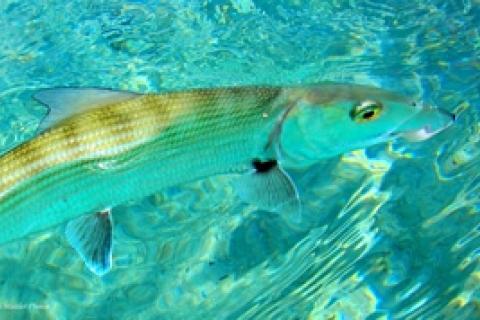
 You may have heard many absolute pronouncements about bonefish from generally acknowledged experts in the field of pursuing the Gray Ghost. As we go over two of these "maxims", you may realize that hard and fast rules in the world of angling are arbitrary and not always true.
You may have heard many absolute pronouncements about bonefish from generally acknowledged experts in the field of pursuing the Gray Ghost. As we go over two of these "maxims", you may realize that hard and fast rules in the world of angling are arbitrary and not always true.
No Current, No Bones
This is a pet theory often advanced in the Florida Keys as well as Biscayne Bay off Miami. I've been hearing this idea since the early 1960s. And in fact, the theory is valid for these bodies of water. The problem arises when those theories are promulgated and mindlessly applied to all the bonefish shallows across the entire globe.
For instance, the famous Marls of Abaco has little if any current, but considered to be a vast food-rich nursery area for the bonefish of the Little Bahama Bank. The major determinant of bonefish presence is determined by height of the water column, which in turn is almost solely determined by wind direction and velocity, not current.
A more esoteric bonefish paradise are the salinas of Bonaire. In this case the "flats" are actually manufactured squared off abandoned salt production pans where the bonefish graze. From an aerial perspective, they look a bit like farm plots. The tidal influence in these waters is nil and the fish are present on a 24/7 basis. The trick in Bonaire is to hope that the almost ever-present ocean breeze on this island calms down enough to see the fish tailing.
Wintertime Means Big Bonefish
Though it may be a fact that many bonefish records have been caught in cooler and temperate weather, it's a big mistake to assume the pursuit of big bonefish should be limited only to these times. My guess is that this theory got started in Florida and the Bahamas but the underpinning of this belief is based on a misunderstanding of the cold weather-big bonefish relationship.
Since fish are cold blooded and rely on external heat, water temperature certainly plays a core role in their behavior. But so does body mass and resultant heat retention. So during a period of cold weather in Florida and the Bahamas (the only two bonefish areas that this occurs in), smaller bonefish with lighter weight and smaller body mass will leave the shallows for the warmer depths more quickly than their bigger brethren.
But this theory should not be misunderstood as to say that during warm weather and even hot weather big bonefish cannot be pursued. I have certain flats that continue to produce big bonefish around dawn and early morning during the hottest weather. And the length of this early morning productivity spans 40 years.
And most importantly, remember that many of the world's best bonefish grounds like Christmas Island, Hawaii, and Los Roques have no real cold weather seasons.
- 3035 views

